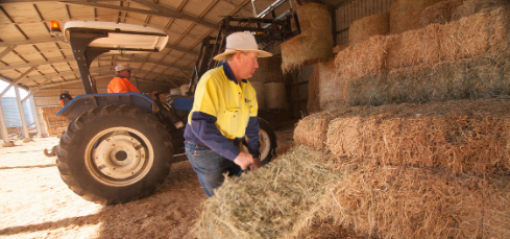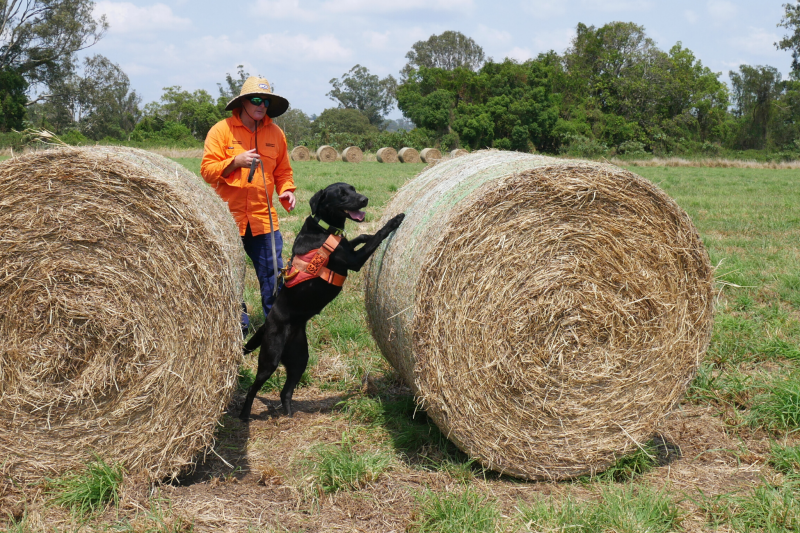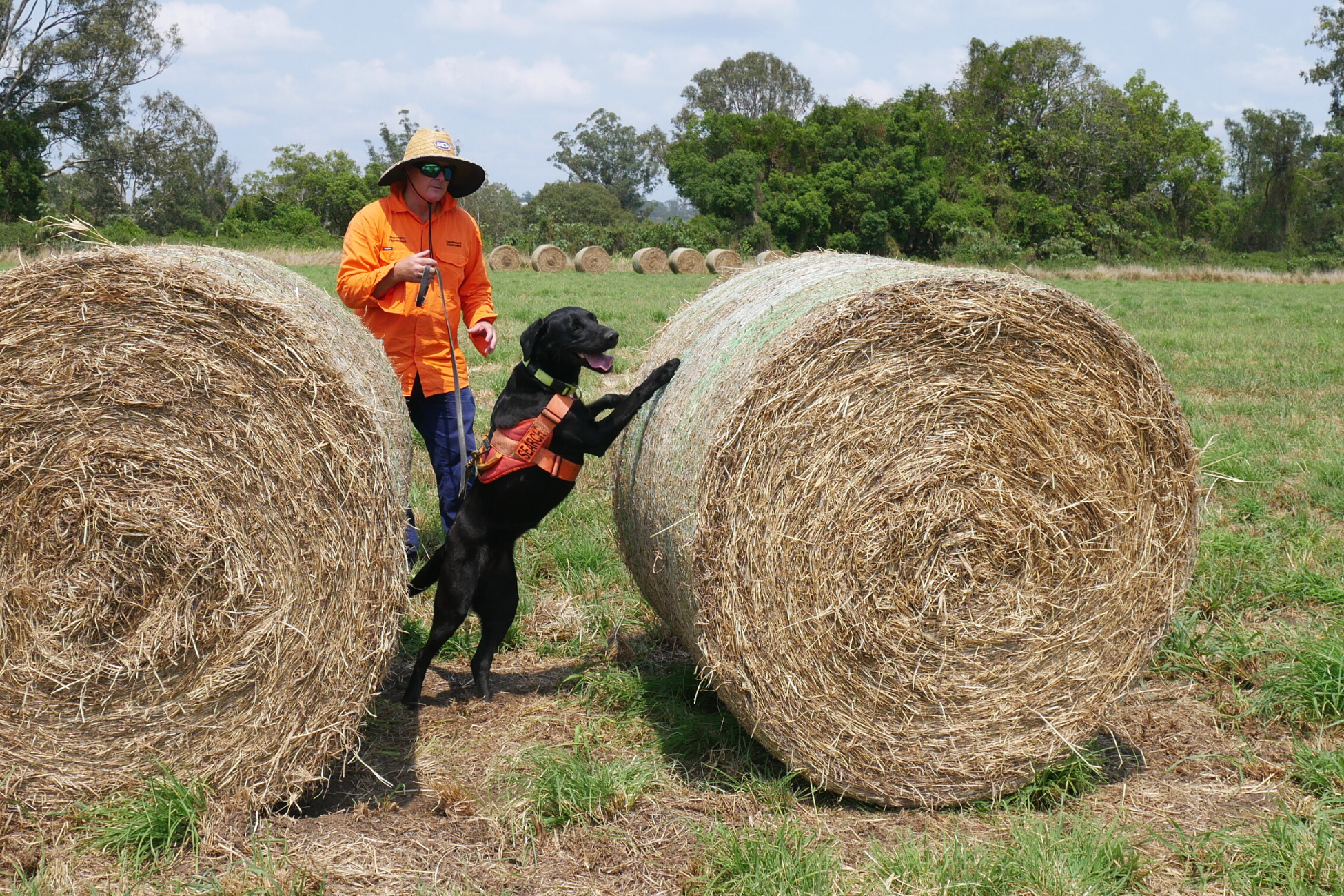The New South Wales Government has temporarily suspended the movement of hay from fire ant infested areas in Queensland into New South Wales. Read more

Baled hay, straw or sugarcane mulch produced inside fire ant biosecurity zones can spread fire ants if appropriate management rules are not followed.
Bales of hay, including lucerne, straw, and sugarcane provide both a food supply, shelter, and micro-climate that is attractive to fire ants.
The Biosecurity Regulation 2016 details a series of steps you must follow when working with hay and other baled products originating from within Queensland’s fire ant biosecurity zones.
On this page
How to be compliant
Keep a written record of the steps you have taken to ensure the materials are produced, processed and stored correctly. Include details about raking, baling and storing activities. Keep these records for a minimum of 2 years.
You should also be checking your property monthly for fire ants, paying special attention to organic material storage areas. This can be done in conjunction with existing property maintenance.
For further information, complete our online fire ant training or contact our compliance team on 13 25 23.
Hay management training video
Fire ants are a biosecurity threat to Australia.
Sugarcane, grass, hay, straw, and any baled materials are considered materials at risk of carrying fire ants. Just because you can't see evidence of fire ants or their mounds doesn't mean the pest isn't there.
That's why anyone working with or purchasing baled material from within the fire ant biosecurity zones must follow the correct production, movement, and storage requirements set out in the Biosecurity Regulation 2016. A few extra minutes of your time could stop fire ants from spreading across South East Queensland and further.
If you farm or produce hay, you can minimise the risk of fire ant infestation by completing the final two rakings within 24 hours of each other and then baling the material within 24 hours of the last raking. Baled materials must then be moved off the paddock within 24 hours.
There are two options for hay storage, on or off-ground.
If storing hay on the ground, you must ensure it is covered with a tarp or stored in a shed and on concrete, strong plastic sheeting, or another material that cannot be penetrated by fire ants. The area should then receive a 30-centimetre bifenthrin perimeter treatment. Remember, if baled materials are stored to feed animals, they should not be placed directly on the treated ground. You should treat the ground and use plastic sheeting. You also cannot store baled materials on sand.
If storing hay off the ground, chemical treatment is not required, however, you must ensure the hay is covered with a tarp or stored in a shed. The use of a hay trailer and a tarp is also an option. A pallet is not appropriate for off-ground storage. If you want to use them, please follow the recommendations for on-ground storage.
In summary, to move baled materials from a property within the fire ant biosecurity zones, you must follow the methods outlined in the video and in the Biosecurity Regulation 2016 or move the material within 24 hours of receiving it or transport the material directly to a nearby waste facility. Restrictions apply, so check our website for more information.
Remember, these requirements are only needed if you intend to move the hay to another property. If you are unable to fulfil these requirements, it may not be safe to move your hay.
Talk to us about your options.
When selling hay, be aware that buyers may ask if the material has been produced and stored in accordance with the regulation. You should always respond to their questions. No one wants to be responsible for bringing this pest into their neighbourhood. Make sure you keep records of the actions taken. These will help prove you are compliant with the regulation. Records must be kept for at least two years, and failure to do so could result in penalties.
Producing hay
The timing of hay production and baling will reduce the risk of fire ant infestation in organic material.
- The final 2 rakings must be conducted within 24 hours of each other.
- Cut material must be baled within 24 hours of the last raking.
- Baled materials must be moved off the property within 24 hours of baling or it must be stored appropriately.
Storing hay
Storing baled materials appropriately is a simple measure to further reduce the risk of fire ant infestation in hay or other baled materials.
If materials are to remain on the property for more than 24 hours, you must use the following storage options:
- off-ground and covered with an effective barrier that prevents alates (flying fire ant queens) from settling in the bales
- on-ground:
- covered with an effective barrier that prevents alates from settling in the bales, and
- stored on a fire ant-resistant surface surrounded by a 30cm wide perimeter treatment using an approved chemical product.
The role of the perimeter treatment and fire ant-resistant surface is to prevent fire ant queens from crawling into the baled materials.
Storing off-ground
Baled materials can be stored off-ground on a trailer and either covered with a tarp or placed inside a shed.
Chemical treatment is not required if storing hay off-ground.
Storing materials on pallets is not considered off-ground storage. Material can easily fall through gaps and form a 'bridge', potentially allowing fire ants to infest the bales. If you want to use pallets, you may do so, but you must follow the recommendations for on-ground storage.
Storing on-ground
Baled hay can be stored on a fire ant-resistant surface. Some examples of fire ant-resistant surfaces include:
- concrete or bitumen (with no cracks)
- a barrier that fire ants cannot penetrate (e.g. 200-micron unperforated continuous plastic sheeting)
- compacted ground (other than sand) that has been treated with an appropriate chemical product before materials are stored.
You must apply a chemical treatment correctly if using on-ground storage. If the material will be stored:
- on a fire ant-resistant surface (as above), apply a 30cm wide perimeter around the storage area
- on compacted ground, the entire ground surface must be treated. Bales likely to be used to feed animals require an impermeable barrier such as rubber mats or plastic sheeting to avoid contamination.
The Australian Pesticides and Veterinary Medicines Authority (APVMA) has approved the use of bifenthrin for the protection of storage areas (PER14317). This permit expires 28 February 2029.
Insecticides must be used under the conditions of the APVMA permit, the safety data sheet (SDS) and in conjunction with the product's label.
Moving hay
You may move baled materials in, across, or outside the fire ant biosecurity zones if you:
- transport material from zone 1 directly to a nearby waste facility in zone 1 or 2
- transport material from zone 2 to a waste facility in zone 2 only
- move the material within 24 hours of it arriving at the original place
- follow the management methods outlined below.
You can also use our material movement advice tool to find out what rules apply to you and your situation.
If cannot comply with these conditions then you must not move the material unless you are granted a biosecurity instrument permit.
Receiving baled materials
Fire ants can travel to your property undetected in organic materials. If receiving baled materials, protect yourself from fire ant infestation by asking the producer, supplier, or delivery driver questions such as:
- Was the material grown or loaded inside a fire ant biosecurity zone?
- If so, ask the supplier the following questions and ensure the answers align with the advice on this page:
- do you know how the material was produced?
- have the bales been left in a paddock for more than 24 hours?
- how have the bales been stored?

